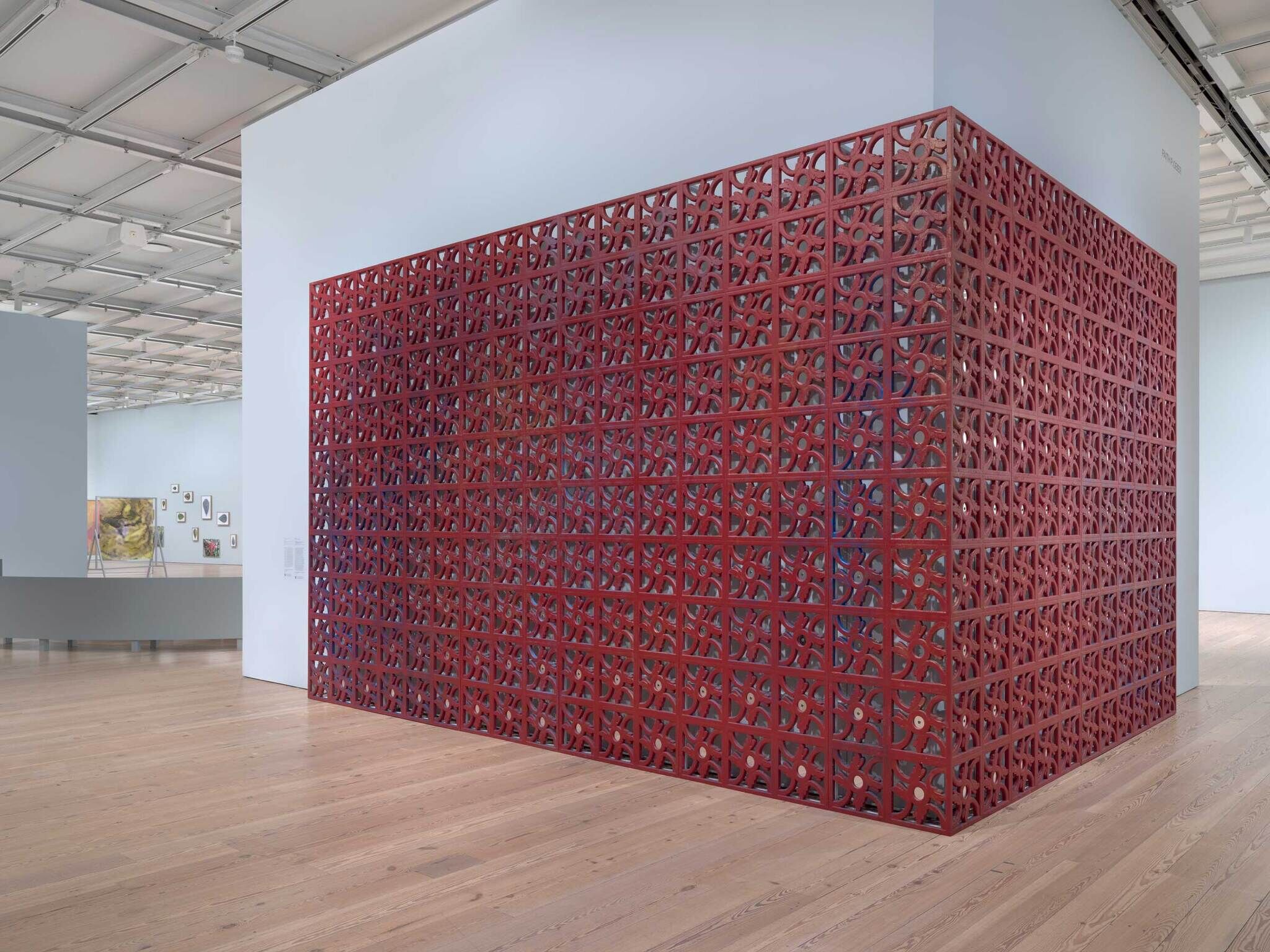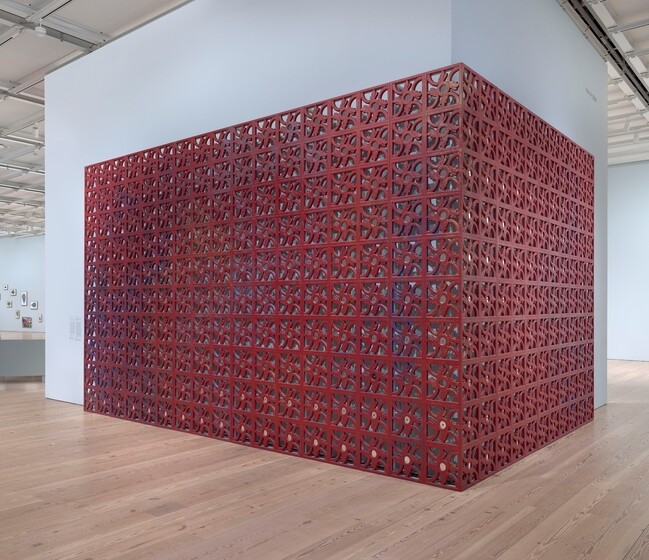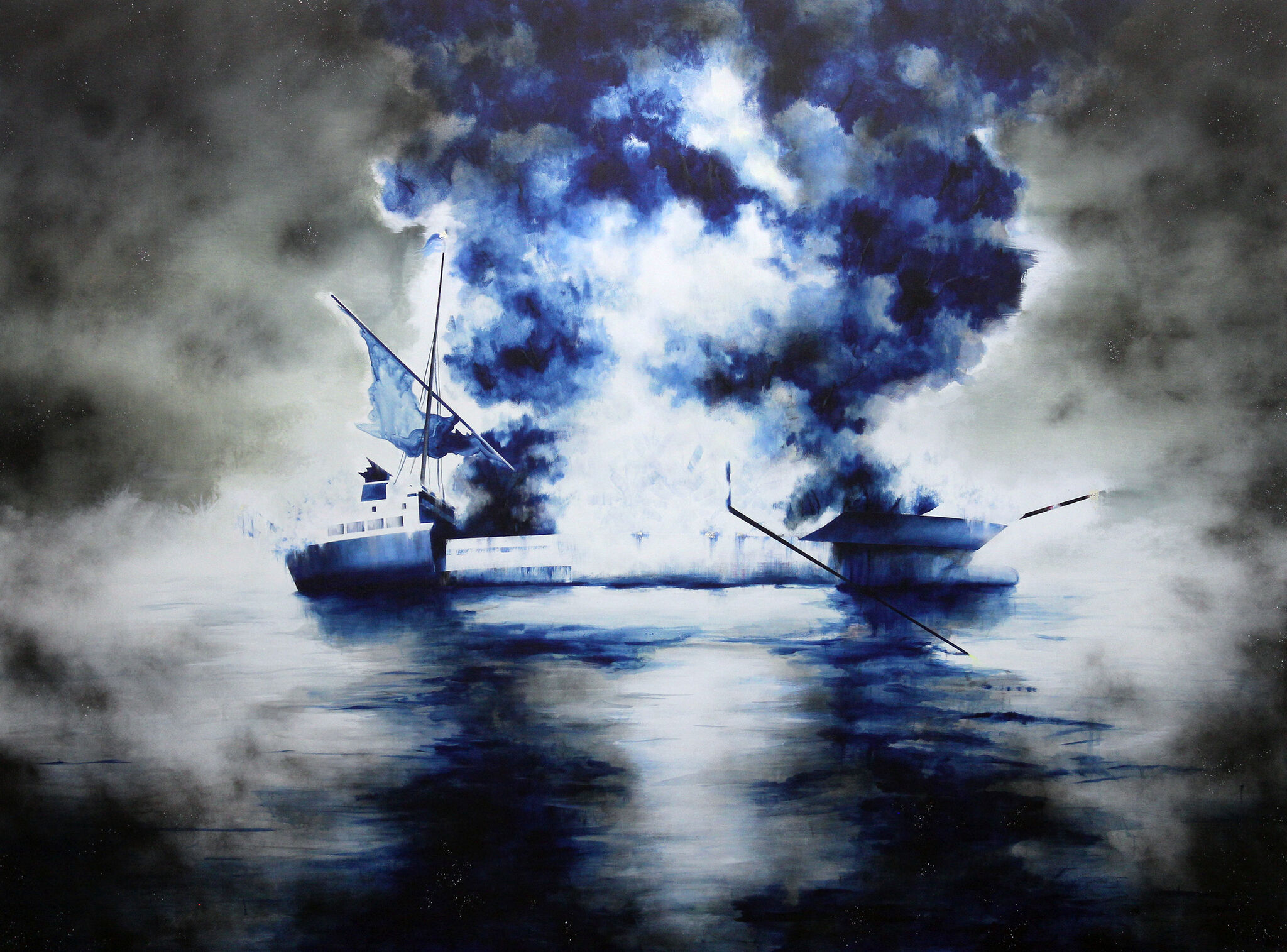Not on view
Date
2022
Classification
Installations
Medium
PVC, latex enamel paint, nine aluminum frames, viewfinders, and inkjet prints
Dimensions
Dimensions variable
Accession number
2023.30a-i
Series
GRAFT
Credit line
Whitney Museum of American Art, New York; purchase, with funds from the Photography Committee
Rights and reproductions
© Edra Soto
Audio
-
Edra Soto, GRAFT, 2022
In no existe un mundo poshuracán: Puerto Rican Art in the Wake of Hurricane Maria (Spanish)
0:00
Edra Soto, GRAFT, 2022
0:00
Edra Soto: Me llamo Edra Soto, y soy artista.
Las formas con las que trabajo son patrones o motivos decorativos que suelen encontrarse en los hogares puertorriqueños. Son nuestras representaciones de estos patrones, que suelen estar elaborados con hierro en bruto o con hormigón. Se utilizan para cercar la fachada de una casa y pueden servir tanto de protección como de ventilación. Se trata de viviendas de clase media y baja que a veces se encuentran en sectores residenciales cerrados, o casas que se construyeron durante los años cincuenta y sesenta. Por lo tanto, son de una época determinada y se encuentran en sectores particulares de Puerto Rico, pero siguen siendo bastante prominentes.
Una de las razones por las que me dedico a replicar este patrón es para representar lo que la migración significa para mí. Y titulé el proyecto como Graft (en español, injerto) porque el injerto hace referencia a un tipo de trasplante de piel.
Estoy intentando crear una imagen de mi experiencia, de alguien que migra constantemente, que ha viajado constantemente entre Puerto Rico y Estados Unidos. Y los registros, que pueden verse a través de los visores integrados en la arquitectura que se representa, ofrecen una mirada más íntima pero también más amplia de cómo podría ser la vida de alguien que vive en la isla, de alguien que es de la isla, pero también de alguien que viaja constantemente a la isla.
Narrador: Las fotografías—algunas tomadas por la propia artista—documentan el huracán María y sus consecuencias.
Edra Soto: Y documenté este momento, porque sé que fue un momento muy importante. Fue un momento muy traumático y fue quizás uno de los peores episodios que he vivido y atravesado como puertorriqueña.
Me llevó dos años poder compartir mis fotos, pero creo que la representación de las rejas ofrece un plano adicional que permite al público tomar una decisión, una decisión voluntaria de acercarse y decidir si va a involucrarse en esta experiencia, si quiere ser testigo. En este sentido, casi se convierte en un tipo de decisión política. ¿Te acercarías voluntariamente? ¿Qué tanto quieres ver? ¿Quieres tomar conciencia de lo que pasó en este lugar?
-
Verbal Description: Introduction
In no existe un mundo poshuracán: Puerto Rican Art in the Wake of Hurricane Maria
0:00
Verbal Description: Introduction
0:00
Narrator: Entering on the sixth floor from the elevators, you will encounter the show, no existe un mundo post huracán, which translates to “a post-hurricane world doesn’t exist.” About thirty six feet ahead of you is a large scale video that is twenty feet wide. In front of you will be an amphitheater of circular seating with standard benches and backrests in the back row and lounge-like seating in the next row in front. In the middle of the amphitheater is a gap for wheelchair users and others to enter, sit and view the work. To the left is a title and intro text that faces east. The design of this exhibition is diffuse without any enclosed rooms, so you can choose your own route. There are multiple opportunities to encounter the video at the entrance of the show as you circulate the exhibition. The walls are painted a pale blue-gray. The light levels are low due to light sensitive works on display.
As you enter to the right is a section titled, “Fractured Infrastructures” starting with Edra Soto's architectural screen titled, “GRAFT” that wraps the wall around the corner. Embedded in this fence-like installation are key chain slide viewers with photographs taken by the artist and other photographers of Hurricane Maria. If you choose to move to the right towards Gabriella Torres-Ferrer’s found object sculpture titled, Valora tu mentira americana, which translates to “Value your American Lie,” you will encounter a fallen lamp post found after hurricane María hit Puerto Rico. The lamp post is in a state of decay and wedged into a triangular corner of the museum gallery. The lamp post is nestled in the gallery corner and projects out along that wall with dangling wires. From there, straight ahead continues with this section an alcove of three paintings along the three walls with potted plants on the floor beneath the paintings by Rogelio Báez Vega to create an installation atmosphere. To the left again is another section titled, “Critiques of Tourism”, with a large painting hung on the wall adjacent to three framed works on paper also hung on the wall by Gamaliel Rodríguez There is a sandcastle on a pedestal floating in space titled Castillos de arena, translating to “Sand Castles” by Yiyo Tirado Rivera to the left along with a large screen displaying the video, B-Roll by Sofía Gallisá Muriente. To the right of the big video there is another space titled, “Processing, Grieving, Reflecting”, with a pedestal displaying several photographs positioned vertically and connected together with thread from the series Ojalá nos encontremos en el mar by Gabriella N. Báez which translates to “Hopefully, We’ll Meet at Sea”. In this space are several other vitrines with objects that belonged to Báez’s father also part of the same series. There is another vitrine on the left wall, displaying a book titled while they sleep (under the bed is another country) by Raquel Salas Rivera. There is an adjacent bench to sit and read through the book. In the next space titled, “Ecological Histories / Landscapes”, there are three free-standing large paintings on armatures that hold them up like sculptural objects that are part of a series titled Air Paintings by Candida Alvarez. In the left corner beyond the paintings is a large video on a projection with Spanish content by Sofía Gallisá Muriente titled Celaje, which translates to “Cloudscape” with multi modal seating that suggests rock formations like those included in the video. The seat to the left is an accessible height and the seat to the right is much lower to the ground.
As you proceed into the final section titled “Resistance, Protest” you are confronted to the left by a wall of graphic posters by Garvin Sierra Vega, embedded within that same wall are monitors displaying video recordings of Taller Gráfico PR’s Instagram feed where the posters originally existed. A project by Miguel Luciano titled Shields / Escudos consisting of ten protest shields installed on posts is in the middle of the room in a V shaped island that you can circulate around. Past this and through a door onto the outdoor terrace, there is a final artwork by Gabriela Salazar titled, Rendering of Reclamation (and Place, Puerto Rico), made of various objects built up and scattered around but not meant to be touched or climbed. Once you return indoors from the terrace, move straight ahead and to the right are the elevators to exit the floor.
-
Descripción verbal: Introducción
In no existe un mundo poshuracán: Puerto Rican Art in the Wake of Hurricane Maria (Spanish)
0:00
Descripción verbal: Introducción
0:00
Narrador: En el sexto piso, al salir de los ascensores, se encuentra la exposición no existe un mundo poshuracán. A unos diez metros delante de usted se muestra un video a gran escala que mide seis metros de ancho. Frente a usted habrá un anfiteatro con asientos dispuestos en forma circular; cuenta con bancos y respaldos comunes en la última fila y asientos tipo butaca en la siguiente fila de adelante. En el centro del anfiteatro hay un espacio para que los usuarios de sillas de ruedas y otras personas puedan entrar, sentarse y ver la obra. A la izquierda se encuentra un título y un texto de introducción orientados hacia el este. El diseño de esta exposición es difuso, ya que no hay salas cerradas, por lo que usted puede elegir su propio recorrido. Hay varias ocasiones en las que podrá encontrarse con el video en la entrada de la muestra y mientras recorre la exposición. Las paredes están pintadas de un gris azulado pálido. El nivel de iluminación es bajo debido a que algunas de las obras expuestas son sensibles a la luz.
Al ingresar hacia la derecha hay una sección llamada “Infraestructuras fracturadas”, que comienza con la reja arquitectónica de Edra Soto titulada Graft, que cubre la pared de la esquina. En esta instalación a modo de valla, hay incorporados unos visores de diapositivas con fotografías del huracán María tomadas por la artista y otros fotógrafos. Si decide avanzar hacia la derecha se topará con la escultura de arte encontrado de Gabriella Torres-Ferrer titulada Valora tu mentira americana, que consiste en un poste de luz caído que se encontró en Puerto Rico tras el paso del huracán María. Este poste de luz está en estado de deterioro y se encuentra insertado en una esquina triangular de la galería del museo. El poste, con cables que cuelgan, está enclavado en la esquina de la galería y se extiende a lo largo de la pared. Desde allí, si sigue en línea recta, encontrará una sección que consiste en un nicho en las tres paredes con tres pinturas de Rogelio Báez Vega; debajo de las pinturas hay plantas en el suelo que crean un ambiente de instalación. A la izquierda hay otra sección titulada “Críticas al turismo”, con una pintura grande de Gamaliel Rodríguez colgada en la pared junto a tres obras enmarcadas en papel, también colgadas en la pared. También a la izquierda hay un castillo de arena sobre un pedestal que parece flotar en el aire, titulado Castillos de Arena, de Yiyo Tirado Rivera, junto a una gran pantalla que muestra el video B-Roll de Sofía Gallisá Muriente. A la derecha del gran video hay otro espacio titulado “Procesar, hacer el duelo, reflexionar”, con un pedestal en el que se exponen varias fotografías colocadas en vertical y unidas entre sí con hilos, de la serie Ojalá nos encontremos en el mar de Gabriella N. Báez. En este espacio hay otras vitrinas con objetos que pertenecieron al padre de Báez y que también forman parte de la serie. En la pared de la izquierda hay otra vitrina con un libro titulado while they sleep (under the bed is another country) de Raquel Salas Rivera. Al lado hay un banco para sentarse y hojear el libro. En el espacio contiguo, titulado “Historias y paisajes ecológicos”, hay tres pinturas grandes colocadas sobre armazones que las elevan como objetos escultóricos; estas pinturas forman parte de la serie Air Paintings de Candida Alvarez. Pasando las pinturas, en la esquina izquierda se proyecta un video de gran tamaño con contenido en español de Sofía Gallisá Muriente titulado Celaje; el espacio cuenta con asientos de varios tipos que evocan formaciones rocosas como las que figuran en el video. El asiento de la izquierda es de una altura accesible y el de la derecha está mucho más cerca del suelo.
A medida que avanza hacia la sección final, titulada “Resistencia, protesta”, a la izquierda se encontrará con una pared de afiches gráficos de Garvin Sierra Vega; en esa misma pared hay monitores que muestran grabaciones de video del perfil de Instagram del Taller Gráfico PR, de donde provienen los afiches. En el centro de la sala, en una isla en forma de V por la que se puede circular, se encuentra el proyecto de Miguel Luciano titulado Shields / Escudos, que consiste en diez escudos de protesta instalados sobre postes. Más allá hay una puerta que da acceso a la terraza exterior, donde se encuentra una última obra de arte de Gabriela Salazar titulada Rendering of Reclamation (and Place, Puerto Rico), que se compone de varios objetos construidos y repartidos por el lugar, los cuales no se pueden tocar ni trepar. Una vez que regrese de la terraza a la sala, siga en línea recta y a la derecha encontrará los ascensores para salir de este piso.
-
Edra Soto, GRAFT, 2022
In no existe un mundo poshuracán: Puerto Rican Art in the Wake of Hurricane Maria
0:00
Edra Soto, GRAFT, 2022
0:00
Edra Soto: My name is Edra Soto. I am an artist.
The types of forms I'm working with are decorative patterns, or decorative motifs, that are found in Puerto Rican homes, are representations of these patterns that are usually made of raw iron or made in concrete. And they are utilized to fence in the facade of a home, and they can be used for protection, as well as ventilation. And these are lower- and middle-class homes that are sometimes located at gated residential sectors, or houses that were built during the fifties and sixties. So they are from a particular time, and live in particular sectors of Puerto Rico. But they are quite prominent still.
One of the reasons that I replicate this pattern is to make a representation of what migration means to me. And I titled the project GRAFT because graft refers to a type of skin transplant.
And I'm trying to create a picture of my experience, of somebody that constantly migrates, and constantly traveled from Puerto Rico to the U.S. And the documentation, that can be experienced through viewfinders, that are embedded in the architecture that is represented will provide an intimate view, but also a more expansive view of what could be the life of somebody that lives in the island, and somebody that is from the island, but also somebody that is constantly traveling to the island.
Narrator: The pictures—some of which Soto took herself—document Hurricane Maria and its aftermath.
Edra Soto: And I documented this moment, because I know it was a very important moment. It was a moment of great trauma, and it was perhaps one of the lowest points that I have lived and experienced as a Puerto Rican.
It took me two years to share my pictures. But I think that having the representation of the fences provides an additional layer that allows for the audience to make a decision, a voluntary decision, to get close, and decide if they are going to invest themselves in this experience, if they want to witness. So, it almost becomes a type of political decision. Are you going to volunteer with yourself? How much do you want to see? Do you want to acknowledge what happened in this place?
Exhibitions
Installation photography
-


Installation view of no existe un mundo poshuracán: Puerto Rican Art In the Wake Of Hurricane Maria (Whitney Museum of American Art, New York, November 23, 2022-April 23, 2023). From left to right: Candida Alvarez, Jellow (Yellow), 2018; Edra Soto, GRAFT, 2022. Photograph by Ron Amstutz
From the exhibition no existe un mundo poshuracán: Puerto Rican Art in the Wake of Hurricane Maria


